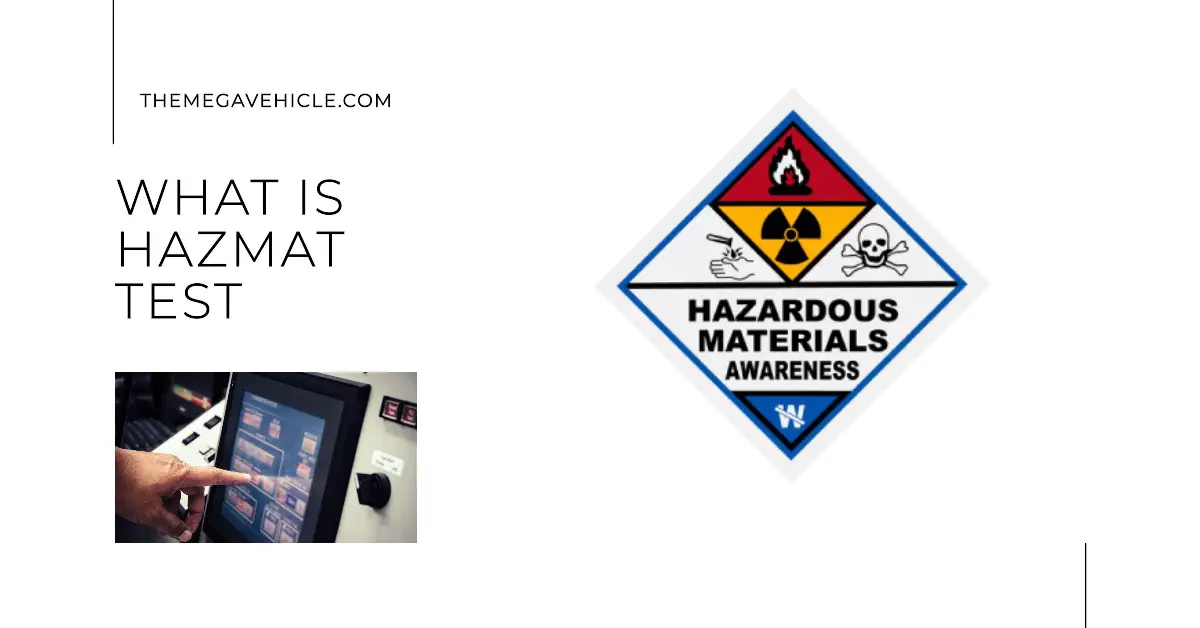What Is Hazmat Test? Assessing Knowledge of Handling Hazardous Materials

Hazmat tests are crucial for ensuring safety in the transportation industry. Hazmat, which stands for hazardous materials, refers to substances that pose a risk to health, safety, and the environment. These materials range from chemicals and gasses to radioactive materials and flammable liquids. Given the potential dangers of transporting hazmat, CDL drivers must undergo rigorous testing to demonstrate their knowledge and competence in safely handling these materials.
What is Hazmat Test, and Why is it Necessary?
A Hazmat test is an examination that evaluates a CDL driver’s knowledge and understanding of the proper handling and transportation of hazardous materials. It assesses their familiarity with the regulations, safety protocols, and emergency response procedures related to hazardous materials. This test is necessary to ensure that CDL drivers can safely transport these materials, reducing the risk of accidents, injuries, and environmental damage.
Why is a hazmat test necessary?
The hazmat test is essential for safeguarding lives and preserving the environment; it is not just a formality. Investing time and effort into completing this exam ultimately results in a safer workplace and greater peace of mind. Here are some key reasons why hazmat testing is important:
1. Protecting Lives and the Environment
Hazmat testing is necessary to ensure that individuals handling hazardous materials know the proper safety protocols and procedures. This knowledge helps prevent accidents, spills, and releases that could harm people and the environment.
2. Mitigating Risks and Liability
Hazmat testing helps organizations identify potential hazards and develop strategies to mitigate risks effectively. By having certified individuals on staff who understand how to handle hazardous materials, organizations can reduce the likelihood of accidents and minimize their liability in the event of an incident.
3. Compliance with Regulations and Standards
Hazmat testing is crucial in ensuring compliance with regulations and standards set by regulatory bodies and organizations. These regulations outline specific requirements for the testing and handling hazardous materials to minimize risks. By conducting hazmat testing, companies can demonstrate their commitment to following these regulations, avoiding legal penalties, and maintaining a safe working environment for their employees and surrounding communities. Compliance with these standards also helps build trust with stakeholders, including customers, suppliers, and regulatory agencies.
4. Mitigating Health Risks
Exposure to hazardous materials can have severe health consequences, ranging from respiratory issues to long-term illnesses and even fatalities. Companies can identify potential risks by conducting regular hazmat testing and implementing appropriate safety measures to protect their employees and the surrounding community. This proactive approach safeguards human health and demonstrates a commitment to responsible environmental stewardship.
5. Enhancing Emergency Preparedness
By conducting thorough testing and simulations, emergency response plans can be developed and refined to ensure effective and timely actions for unforeseen events. This includes training personnel on proper handling procedures, establishing communication protocols, and coordinating with relevant authorities to minimize the potential consequences of emergencies.
Table of Contents
What topics are covered in the CDL hazmat test?
The CDL hazmat test is a comprehensive examination that assesses an individual’s knowledge and understanding of handling hazardous materials while operating commercial vehicles. The test covers various topics, including but not limited to:
1. Types of hazardous materials
The CDL hazmat test covers different hazardous materials, such as explosives, flammable liquids, toxic substances, and radioactive materials. It also includes information on adequately handling and transporting each type of hazardous material.
2. Hazardous materials regulations
The CDL hazmat test also covers the regulations and guidelines the Department of Transportation (DOT) sets for transporting hazardous materials. This includes understanding the proper labeling, placarding, and packaging requirements for different hazardous materials.
3. Loading and unloading procedures
This includes appropriately handling and securing hazardous materials during loading and unloading to prevent accidents or spills.
4. Emergency response procedures
This assesses the individual’s understanding of the necessary steps to take in an emergency, such as safely evacuating the area and contacting emergency services. It also evaluates their knowledge of using fire extinguishers and other emergency equipment effectively. Additionally, it includes assessing their ability to follow established protocols for reporting incidents and communicating with relevant authorities.
5. Safety precautions and equipment
The Hazmat test also covers safety precautions and the proper use of equipment while handling hazardous materials. This includes educating people on the importance of wearing personal protective equipment (PPE) such as gloves, goggles, and respirators and providing guidance on handling and storing hazardous materials properly. Additionally, it emphasizes the need for regular inspections and maintenance of safety equipment to ensure its effectiveness in emergency situations.
6. Documentation and record-keeping
The CDL hazmat test also covers documentation and recordkeeping requirements for transporting hazardous materials. This includes understanding the proper completion of shipping papers, bills of lading, and other necessary documents to ensure compliance with regulations. Additionally, it covers the importance of accurate record-keeping for tracking and reporting hazardous materials during transportation.
7. Environmental protection regulations
Environmental protection regulations are another important topic covered in the CDL hazmat test. This includes understanding how to properly handle and dispose of hazardous materials to prevent environmental harm.
The Benefits of Hazmat Certification For Career
A Hazmat certification has numerous benefits that can significantly enhance your professional career. Let’s take a closer look at some of these advantages:
1. Job Opportunities and Advancement
A Hazmat certification opens up a wider range of job opportunities in industries dealing with hazardous materials, such as manufacturing, logistics, and transportation. Employers often prioritize candidates with this certification, giving you a competitive edge in the job market. Additionally, some companies may require their employees to have Hazmat certification as a prerequisite for certain positions, making you more eligible for advancement within your current organization.
2. Increased Safety
Obtaining a Hazmat certification ensures you have the knowledge and skills to handle hazardous materials safely. This protects yourself and reduces the risk of accidents and potential harm to others in the workplace.
3. Compliance with Regulations
A Hazmat certification demonstrates your commitment to following regulations and guidelines set by government agencies such as the Occupational Safety and Health Administration (OSHA) and the Department of Transportation (DOT). This can help your employer avoid costly fines and penalties for non-compliance, highlighting your value as an employee.
4. Professional Credibility
Having a Hazmat certification can enhance your professional credibility and demonstrate your commitment to safety and compliance in hazardous materials handling. This can make you a more attractive candidate for employers and increase your chances of securing higher-level positions or promotions within your field.
5. Personal Growth
Obtaining a Hazmat certification can also contribute to your personal growth by expanding your understanding of safety protocols and regulations in your industry. It allows you to continuously improve and stay updated on the latest practices, which can lead to a sense of fulfillment and self-confidence in your professional abilities. Additionally, the knowledge gained from this certification can be applied to various aspects of your life, such as ensuring safety at home or in other environments where hazardous materials may be present.
Frequently Asked Questions
Q1. How to pass the hazmat test?
A. To pass the Hazmat test, it is important to thoroughly study and understand the materials covered in the certification course. This includes familiarizing yourself with hazardous material classifications, containment methods, and decontamination procedures. Additionally, practicing sample test questions and scenarios can help you become more comfortable applying your knowledge in real-world situations.
Q2. What are the three major types of hazmat?
A. The three major types of hazmat are flammable and combustible materials, toxic substances, and corrosive materials. Flammable and combustible materials can easily catch fire or explode, while toxic substances can cause harm or death when exposed to living organisms. Corrosive materials can erode or destroy other substances upon contact. It is crucial to handle and transport these hazardous materials with caution to prevent accidents and protect human health and the environment.
THE BOTTOM LINE
HAZMAT tests are essential for protecting people, property, and the environment when dealing with hazardous materials. They are intended to ensure that individuals and organizations are adequately prepared to handle hazardous materials safely and following rules. Passing a HAZMAT test indicates a commitment to safety and environmental responsibility, whether you’re a truck driver hauling chemicals or an emergency responder dealing with hazardous materials occurrences. Through these tests, we may reduce risks, prevent accidents, and lessen the potentially disastrous effects of mishandling hazardous materials.






